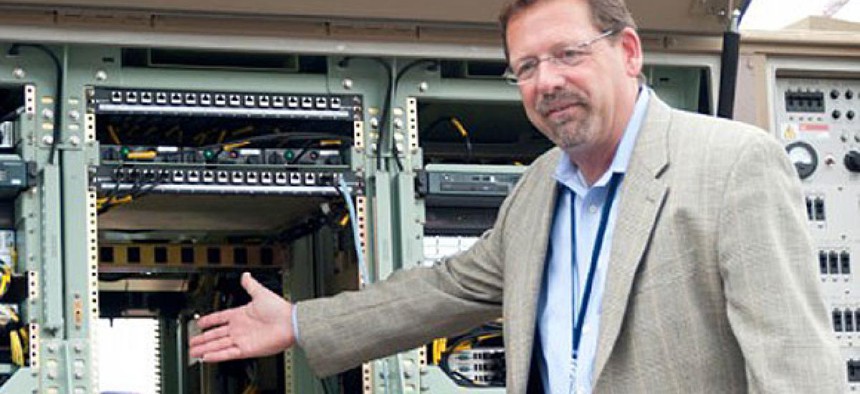Contractor: Configuration issues skewed tests of battlefield radio

Chris Marzilli, president of General Dynamic’s C4 system unit General Dynamics
Noisy environment and ergonomics issues also led to poor grades, company says.
General Dynamics Corp.’s manpack battlefield radio performed poorly in tests this spring because of configuration issues and the noisy radio frequency environment at White Sands Missile Range, N.M., a company official told Nextgov on Thursday.
Ergonomic problems, which the company has since fixed, also contributed to poor grades, Chris Marzilli, president of General Dynamic’s C4 system unit, said in an interview. The Army is close to buying the company’s Joint Tactical Radio System manpack version, but J. Michael Gilmore, director of operational test and evaluation for the Defense Department, deemed it operationally ineffective and unsuitable in a July report that focused heavily on the performance of the radio’s Single Channel Ground and Airborne Radio System (SINCGARS) waveform. A waveform is software that defines bandwidth, frequency, modulation, security and data rates.
During the Network Integration Evaluation Exercise at White Sands in April and May, the SINCGARS waveform demonstrated less than half the range of older legacy radios, according to Gilmore’s report: 7 kilometers versus 20 kilometers. SINCGARS voice quality on the General Dynamics radio “was often poor, garbled and unintelligible,” Gilmore added.
Marzilli said this reflected the way the Army installed and configured the AN/PRC-155 manpack for mine resistant-ambush protected vehicles. The installation method reduced the radio’s range, he said.
Numerous transmitters at White Sands created noise that also affected the performance of the manpack in SINCGARS mode, which led to interference between other onboard systems and the manpack, according to Marzilli.
In cooperation with the Army, General Dynamics improved the configuration of the radio in vehicles currently undergoing development tests at the Electronic Proving Ground at Fort Huachuca, Ariz. Marzilli said he believes this will clear up many the problems encountered during the spring White Sands tests. The radio frequency environment at the Electronic Proving Ground is less noisy, he noted, and provides more realistic conditions.
Pentagon testers also dinged General Dynamics for another issue related more to ergonomics than performance, Marzilli said.
When soldiers pull out the power switch and turn on the device -- a move they are familiar with from older SINCGARS radios -- this “zeroes out” the General Dynamics manpack, which then takes 20 to 25 minutes to reboot. Marzilli said this accounted for 12 of 66 problems identified during the White Sands tests.
General Dynamics has fixed this ergonomic issue by designing a new power knob for the radio, according to Marzilli.
Gilmore criticized the General Dynamics manpack for a weight increase from the required 14.6 pounds to 18.8 pounds. But Marzilli said this 4.2 pound increase should be put into perspective with other radios and fact in that the General Dynamics manpack radio has two channels: SINCGARS and another running the Soldier Radio Waveform, which Gilmore called “operationally useful.”
The AN/PRC-117G radio from Harris Corp. operates only on a single channel and weighs 12.2 pounds, Marzilli noted. By contrast, a soldier equipped with General Dynamic’s AN/PRC-155 ends up with a two-channel radio that does not weigh as much as having to carry two separate radios, he said.
Frank Kendall, undersecretary of Defense for acquisition, technology and logistics, is supposed to decide by early October -- based on the results of the Electronic Proving Ground tests -- on whether to buy nearly 4,000 manpacks at an estimated cost of $296 million.
Marzilli said General Dynamics and its manpack partner, Rockwell Collins, are so confident Defense will greenlight the project that they have invested “tens of millions of dollars” to produce the radios.
NEXT STORY: The Rising Star judges



